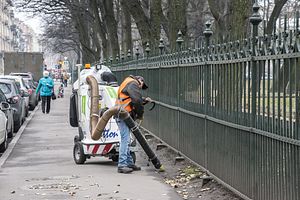A brawl involving an estimated 200 people broke out at a cemetery southwest of Moscow on Saturday. Three people were killed in the fighting at Khovanskoye cemetery, which Russian authorities say took place between migrants from different parts of the former Soviet Union.
The fight, characterized as a “turf war” by RT, reportedly began when a group of men from the North Caucasus confronted a group of Central Asian migrants in the cemetery. Videos from the cemetery show groups of men, some armed with shovels, bats, and iron rods, running by a yard of headstones, throwing rocks at each other and brawling back and forth across the cemetery; what sounds like gunshots can be heard in some of the videos. More than 90 people were arrested.
Citing the interior ministry, The Guardian, reported that the fight “appeared to have been caused by a dispute over the rights to provide burial servies (sic) in the cemetery.” RIA Novosti cited cemetery officials as saying that men from the North Caucasus attacked migrants from Uzbekistan and Tajikistan working in the cemetery. RT commented that the migrants working in the cemetery were not official employees but rather workers paid by the families of the deceased to care for grave sites. The AFP cited a representative of the Tajik diaspora, Karomat Sharipov, as saying that two of the dead were Tajik nationals who had worked in Russia for more than 20 years. “Organised crime gang members came, they demanded that they give them 20 percent of their income,” Sharipov said. Russian media has characterized the brawlers as illegal migrants.
While the root of the brawl seems less ethnic and more gang-related–linked to what can best be described as “spheres of influence” over who works (and who gets paid) in the lucrative grave-tending business–the resulting news coverage further casts a dark shadow on Russia’s migrant populations.
Sunday at a meeting of the State Duma, Igor Lebedev, a deputy of the far-right Liberal Democratic Party of Russia (LDPR), said that it’s necessary for Russia to close its border to Central Asian migrants. This is not the first time Lebedev has suggested such a measure–he made the same call after the Paris attacks in November 2015–and he is not the only member of the Russian government to do so in response to the cemetery brawl.
Evgeny Serebrennikov, deputy chairman of the Committee on Defense and Security at Russia’s Federation Council, said that he would support the introduction of a visa regime with Tajikistan and Uzbekistan. Presently citizens of Tajikistan and Uzbekistan (as well as other CIS states) do not need a visa to enter Russian territory, though they are required to get approval to remain for more than 90 days for work or schooling. Many migrants opt not to–in recent years the hurdles for obtaining work permits have risen–and therefore remain in the country illegally.
With Russia’s economy in recession, migrant workers are increasingly seen in negative light. The source countries for migrants, like Tajikistan, are experiencing their own economic downturns, but while fortunes in Russia are dwindling (the value of remittances has fallen drastically), the country still presents more opportunities than staying home. Xenophobia is not a new phenomenon in Russia, but as the cemetery brawl demonstrates, conflict over economic opportunities lends itself to ethnic or national lines of division.
The ethnic character of violence like that seen in the cemetery (regardless of the fact the fight was likely more about access to jobs in the cemetery than ethnicity or nationality) reinforces negative stereotypes regarding migrants, making difficult lives even more difficult.
Uzbekistan and Tajikistan have both not pursued membership in the Eurasian Economic Union, which would smooth some of the difficult processes to obtaining work permits. But in many ways the damage is done and migrant workers from the two countries–whether they’re in the country legally or illegally–are viewed in a negative light. This view–of migrants as sources of violence–is reinforced by the fact that many Central Asians who have joined ISIS have been recruited while in Russia. As the stereotype of migrants as sources of violence and extremism grows, migrant communities become ever more separated from the larger communities in which they live, leading to further marginalization and, sadly, more violence.

































